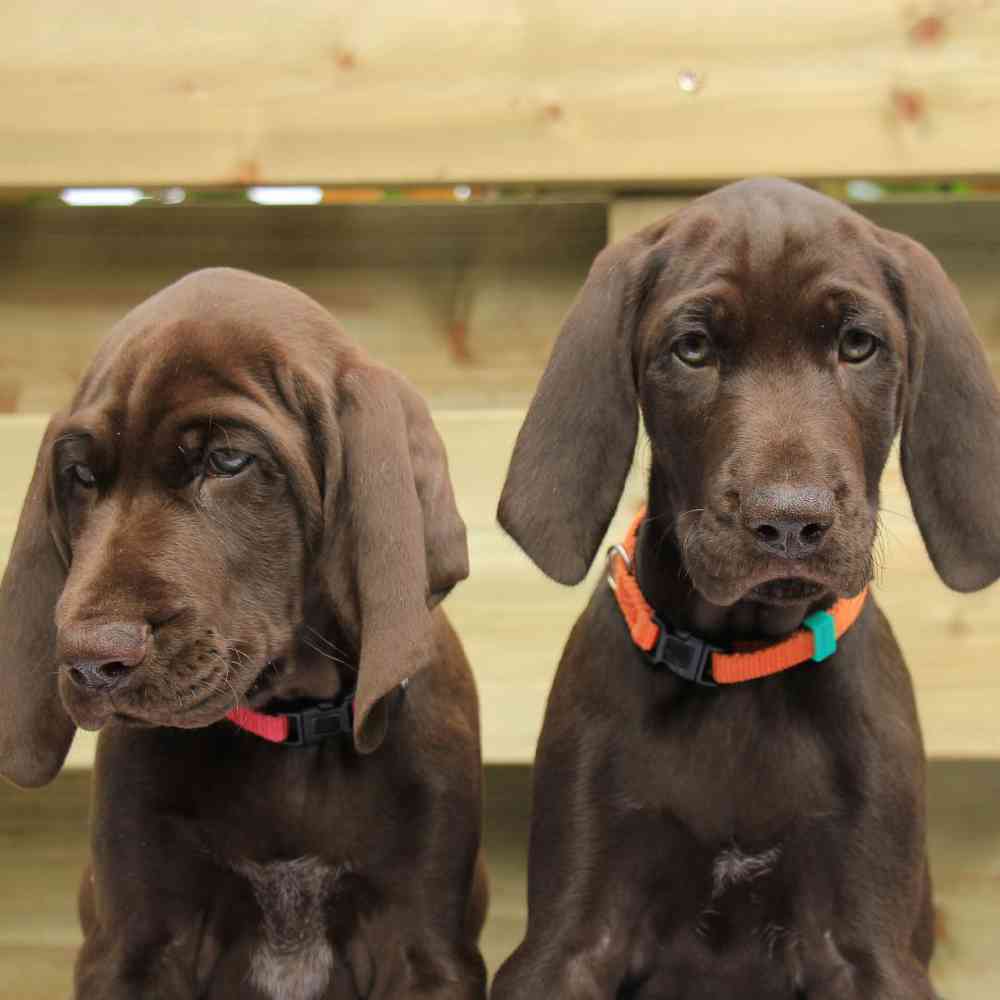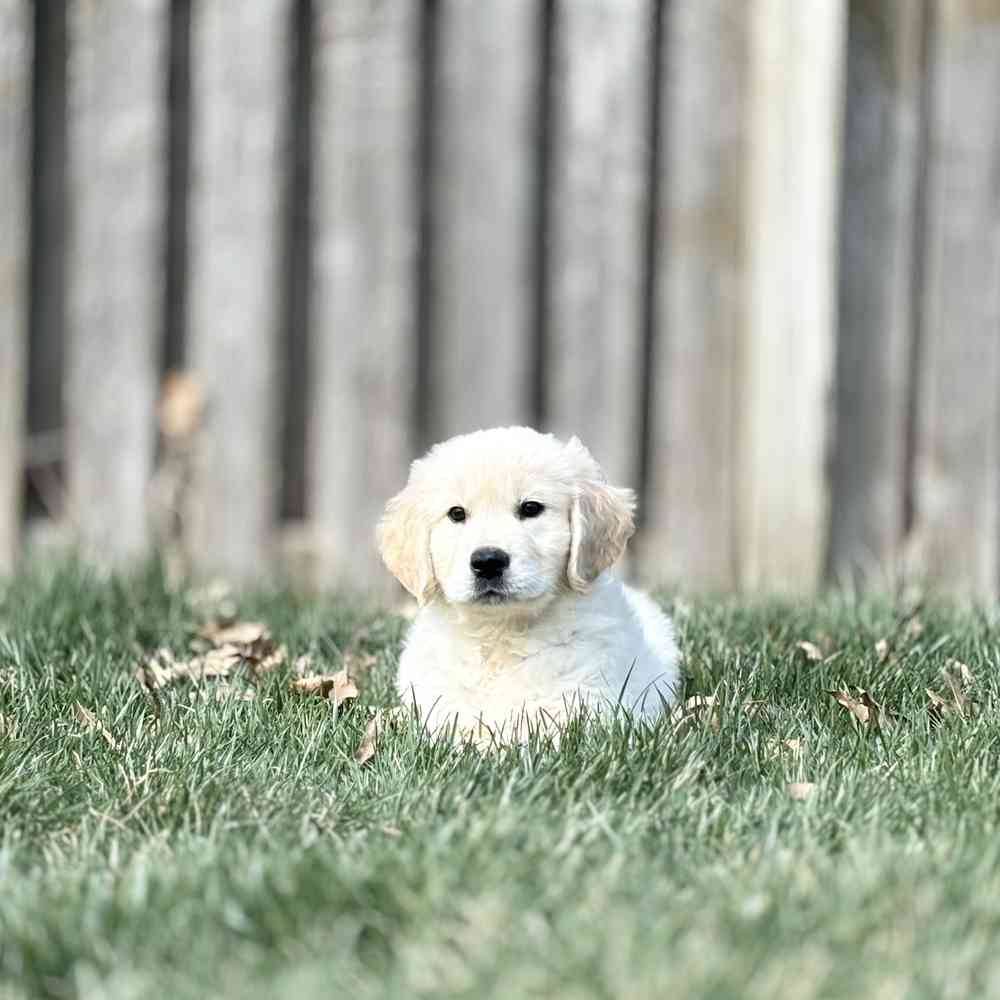
AKC Registrable
German Shorthaired Pointer
The versatile, medium-sized German Shorthaired Pointer is an enthusiastic gundog of all trades who thrives on vigorous exercise, positive training, and a lot of love. GSP people call their aristocratic companions the “perfect pointer.”
Available Pups
Puppy Knowledge
Breed Info
Clubs, Registries & Associations
American Canine Association Continental Kennel Club Universal Kennel Club International American Kennel Club United All Breed Registry America's Pet Registry, Inc. United Kennel Club (Based on breed recognition. See store for details on this particular puppy.)
Group
Sporting
Heritage
The development of the German Shorthaired Pointer is unknown. What is known is that this breed originated in 19th century Germany, likely developed from several German hunting and scent breeds resulting in a multitalented sporting and hunting gundog.
Description
Large, 21-25” at the shoulders, weighing anywhere from 45-70 pounds. The German Shorthaired Pointer has a sturdy, muscular body with a short, dense coat that comes in colors of solid liver, liver ticked or patches, liver with white, liver roan or white ticked.
Health Awareness
The German Shorthaired Pointer has a life expectancy of 12- 15 years and is prone to hip dysplasia, epilepsy, gastric torsion, and entropion.
Personality
The German Shorthaired Pointer is alert, high-spirited, enthusiastic, happy-go-lucky, and friendly with people they know, but are reserved with strangers. They are intelligent and happy to learn, sensitive and loyal. Very high energy and will need a daily outlet for physical exercise as well as mental stimulation. Give your German Shorthaired Pointer gentle yet consistent guidance to demonstrate that you are a capable leader, or this breed will feel the need to provide their own leadership that can result in other behavior issues. Socialize this breed on a continual basis and be sure to provide structure and order. This breed does not do well with a chaotic household.
Exercise/Energy Level
Very high energy. Think JRS when picking exercises with this breed: jumping, running, swimming. A highly active breed, your German Shorthaired Pointer needs a lot of exercise such as several daily brisk walks, along with plenty of aerobic exercise (running). Jogging, hunting, agility, flyball and tracking are additional good activities to do with your German Shorthaired Pointer. A good game of disc dog is fun for you and your German Shorthaired Pointer, and they excel as a dock dog.
Additional Information
Grooming Requirements: Requires regular brushing; bathe only when necessary to prevent stripping the natural oils from the coat. Coat: Short Shedding: Average Shedding Hypoallergenic: No, due to shedding Apartment Living: Not good for apartment living due to high exercise needs Lap Dog: No Good With Children: Good with all children Good With Other Pets: Generally good with other pets when well socialized at an early age; will chase cats
Breed Standard
General Appearance
The German Shorthaired Pointer is a versatile hunter, an all-purpose gun dog capable of high performance in field and water. The judgement of Shorthairs in the show ring reflects this basic characteristic. The overall picture which is created in the observer’s eye is that of an aristocratic, well balanced, symmetrical animal with conformation indicating power, endurance and agility and a look of intelligence and animation. The dog is neither unduly small nor conspicuously large. It gives the impression of medium size, but is like the proper hunter, "with a short back, but standing over plenty of ground." Symmetry and field quality are most essential. A dog in hard and lean field condition is not to be penalized; however, overly fat or poorly muscled dogs are to be penalized. A dog well balanced in all points is preferable to one with outstanding good qualities and defects. Grace of outline, clean-cut head, sloping shoulders, deep chest, powerful back, strong quarters, good bone composition, adequate muscle, well carried tail and taut coat produce a look of nobility and indicate a heritage of purposefully conducted breeding. Further evidence of this heritage is movement which is balanced, alertly coordinated and without wasted motion.
Size, Proportion, Substance
Size--height of dogs, measured at the withers, 23 to 25 inches. Height of bitches, measured at the withers, 21 to 23 inches. Deviations of one inch above or below the described heights are to be severely penalized. Weight of dogs 55 to 70 pounds. Weight of bitches 45 to 60 pounds. Proportion--measuring from the forechest to the rearmost projection of the rump and from the withers to the ground, the Shorthair is permissibly either square or slightly longer than he is tall. Substance--thin and fine bones are by no means desirable in a dog which must possess strength and be able to work over any type of terrain. The main importance is not laid so much on the size of bone, but rather on the bone being in proper proportion to the body. Bone structure too heavy or too light is a fault. Tall and leggy dogs, dogs which are ponderous because of excess substance, doggy bitches, and bitchy dogs are to be faulted.
Head
The head is clean-cut, is neither too light nor too heavy, and is in proper proportion to the body. The eyes are of medium size, full of intelligence and expression, good-humored and yet radiating energy, neither protruding nor sunken. The eye is almond shaped, not circular. The preferred color is dark brown. Light yellow eyes are not desirable and are a fault. Closely set eyes are to be faulted. China or wall eyes are to be disqualified. The ears are broad and set fairly high, lie flat and never hang away from the head. Their placement is just above eye level. The ears when laid in front without being pulled, should extend to the corner of the mouth. In the case of heavier dogs, the ears are correspondingly longer. Ears too long or fleshy are to be faulted. The skull is reasonably broad, arched on the side and slightly round on top. Unlike the Pointer, the median line between the eyes at the forehead is not too deep and the occipital bone is not very conspicuous. The foreface rises gradually from nose to forehead. The rise is more strongly pronounced in the dog than in the bitch. The jaw is powerful and the muscles well developed. The line to the forehead rises gradually and never has a definite stop as that of the Pointer, but rather a stop-effect when viewed from the side, due to the position of the eyebrows. The muzzle is sufficiently long to enable the dog to seize game properly and be able to carry it for a long time. A pointed muzzle is not desirable. The depth is in the right proportion to the length, both in the muzzle and in the skull proper. The length of the muzzle should equal the length of skull. A dish-shaped muzzle is a fault. A definite Pointer stop is a serious fault. Too many wrinkles in the forehead is a fault. The nose is brown, the larger the better, and with nostrils well opened and broad. A spotted nose is not desirable. A flesh colored nose disqualifies. The chops fall away from the somewhat projecting nose. Lips are full and deep yet are never flewy. The teeth are strong and healthy. The molars intermesh properly. The bite is a true scissors bite. A perfect level bite is not desirable and must be penalized. Extreme overshot or undershot disqualifies.
Neck, Topline, Body
The neck is of proper length to permit the jaws reaching game to be retrieved, sloping downwards on beautifully curving lines. The nape is rather muscular, becoming gradually larger toward the shoulders. Moderate throatiness is permitted. The skin is close and tight. The chest in general gives the impression of depth rather than breadth; for all that, it is in correct proportion to the other parts of the body. The chest reaches down to the elbows, the ribs forming the thorax show a rib spring and are not flat or slabsided; they are not perfectly round or barrel-shaped. The back ribs reach well down. The circumference of the thorax immediately behind the elbows is smaller than that of the thorax about a hand’s breadth behind elbows, so that the upper arm has room for movement. Tuck-up is apparent. The back is short, strong, and straight with a slight rise from the root of the tail to the withers. The loin is strong, is of moderate length, and is slightly arched. An excessively long, roached or swayed back must be penalized. The hips are broad with hip sockets wide apart and fall slightly toward the tail in a graceful curve. A steep croup is a fault. The tail is set high and firm, and must be docked, leaving approximately 40% of its length. The tail hangs down when the dog is quiet and is held horizontally when he is walking. The tail must never be curved over the back toward the head when the dog is moving. A tail curved or bent toward the head is to be severely penalized.
Forequarters
The shoulders are sloping, movable, and well covered with muscle. The shoulder blades lie flat and are well laid back nearing a 45 degree angle. The upper arm (the bones between the shoulder and elbow joint) is as long as possible, standing away somewhat from the trunk so that the straight and closely muscled legs, when viewed from the front, appear to be parallel. Elbows which stand away from the body or are too close result in toes turning inwards or outwards and must be faulted. Pasterns are strong, short and nearly vertical with a slight spring. Loose, short-bladed or straight shoulders must be faulted. Knuckling over is to be faulted. Dewclaws on the forelegs may be removed. The feet are compact, close-knit and round to spoon-shaped. The toes are sufficiently arched and heavily nailed. The pads are strong, hard and thick.
Hindquarters
Thighs are strong and well muscled. Stifles are well bent. Hock joints are well angulated and strong with straight bone structure from hock to pad. Angulation of both stifle and hock joint is such as to achieve the optimal balance of drive and traction. Hocks turn neither in nor out. Cowhocked legs are a serious fault.
Coat
The hair is short and thick and feels tough to the hand; it is somewhat longer on the underside of the tail and the back edges of the haunches. The hair is softer, thinner and shorter on the ears and the head. Any dog with long hair in the body coat is to be severely penalized.
Color
The coat may be of solid liver or a combination of liver and white such as liver and white ticked, liver patched and white ticked, or liver roan. A dog with any area of black, red, orange, lemon or tan, or a dog solid white will be disqualified.
Gait
A smooth lithe gait is essential. It is to be noted that as gait increases from the walk to a faster speed, the legs converge beneath the body. The tendency to single track is desirable. The forelegs reach well ahead as if to pull in the ground without giving the appearance of a hackney gait. The hindquarters drive the back legs smoothly and with great power.
Temperament
Friendly, Smart, Willing to Please
Disqualifications
China or wall eyes. Flesh colored nose. Extreme overshot or undershot. A dog with any area of black, red, orange, lemon, or tan, or a dog solid white.
Overview
About
Male German Shorthaired Pointers stand between 23 and 25 inches at the shoulder and weigh anywhere from 55 to 70 pounds; females run smaller. The coat is solid liver (a reddish brown), or liver and white in distinctive patterns. The dark eyes shine with enthusiasm and friendliness. Built to work long days in the field or at the lake, GSPs are known for power, speed, agility, and endurance. “Noble” and “aristocratic” are words often used to describe the overall look. GSPs make happy, trainable pets who bond firmly to their family. They are always up for physical activities like running, swimming, organized dog sports—in fact, anything that will burn some of their boundless energy while spending outdoors time with a human buddy.
History
German hunters spent generations crossing various breeds until they perfected this versatile bird dog sometime in the 1800s. They were so successful that, to this day, GSPs are among the top-winning breeds in competitive hunting events. The German bird-dog tradition dates to at least the 1700s, with master breeders experimenting with tracking hound–pointing dog crosses in the quest for a quick but powerful hunter possessing plenty of nose and versatility. It comes as no surprise to learn that a key player in the early development of this breed of noble bearing was himself a nobleman, Prince Albrecht zu Solms-Braunfels. The prince and his fellow enthusiasts succeeded beyond their wildest imaginings in creating a do-it-all hunting dog. Here, a breed historian ticks off the GSP’s credentials: “a staunchly pointing bird dog; a keen-nosed night trailer; a proven duck dog; a natural retriever on land or water, with pleasing conformation and markings, and great powers of endurance; and an intelligent family watchdog and companion.” The GSP has been hunted with success on a variety of quarry: gamebirds, possum, rabbit, raccoon, and even deer. With his webbed feet and sleek but sturdy construction, the GSP burnishes his résumé as one of dogdom’s finest swimmers. Emblematic of the breed’s eager versatility was Marvin, a GSP from North Carolina, who in late 2013 achieved his 75th AKC title.
Standard
The German Shorthaired Pointer is a versatile hunter, an all-purpose gun dog capable of high performance in field and water. The judgment of Shorthairs in the show ring reflects this basic characteristic. The overall picture which is created in the observer’s eye is that of an aristocratic, well balanced, symmetrical animal with conformation indicating power, endurance and agility and a look of intelligence and animation. The dog is neither unduly small nor conspicuously large. It gives the impression of medium size, but is like the proper hunter, “with a short back, but standing over plenty of ground.” Symmetry and field quality are most essential.
Nutrition
Feed a high-quality dog food that is appropriate to the dog’s age (puppy, adult, or senior) and activity level. A pup under 6 months old will need to be fed more than twice a day; once the GSP reaches adulthood, a meal morning and evening should be sufficient. Because the breed is subject to bloat, they should not be fed immediately after running or other vigorous exercise, nor should they be allowed to run or exercise for at least an hour after eating and drinking. The ideal evening mealtime would be after physical activities are through for the day.
Grooming
The GSPs coat is easy to groom most of the year, requiring only a good once-over with a brush or grooming glove every few days. Although the coat is short, it still sheds—especially at certain times of the year, when more frequent brushing will be needed to remove the loose hairs before they end up all over the house. The hairs can become embedded in fabrics and carpet and hard to get out. An occasional bath (using a gentle shampoo) can help. The ears should be regularly inspected and cleaned, and the nails trimmed short.
Exercise
The GSP does best with plenty of exercise and things to do, such as running, swimming, and dog sports—in fact, anything that will burn some of their boundless energy while spending time outdoors with a human buddy. Their routine should ideally include ample physical activity twice a day. This might be in the form of brisk, half-hour walks morning and evening or running and playing in a securely fenced area. GSPs are smart and athletic and excel in a wide range of canine activities that exercise mind and body, from field eventsto agility, obedience, and dock diving.
Training
Early training is essential for the German Shorthaired Pointer. Socializationand puppy training classes are vital, continuing with practice in basic obedience commands. This is an intelligent breed that learns quickly with consistent training sessions. GSPs need a purpose, and without one they can be destructive if left to their own devices. The breed can be extremely challenging from 6 months to 3 years old. GSPs have a very high energy level and a strong prey drive, and they need an owner with an active lifestyle to guide the dog’s exuberance and intensity into positive outlets.
Health
Although German Shorthaired Pointers are generally healthy, there are some conditions the breed may be prone to. Among these are hip dysplasia, eye conditions such as progressive retinal atrophy, and certain heart diseases. A responsible breeder will screen their breeding stock for conditions that affect the breed. GSPs can also be affected by bloat, a life-threatening condition where the stomach suddenly distends and often twists as well. Owners should educate themselves as to what symptoms indicate this is occurring and what to do should it occur.
Trivia
Interesting To Know
Colter: The True Story Of The Best Dog I've Ever Had by Rick Bass is the story of living with a German Shorthaired Pointer in Montana. Mel Wallis wrote about sharing his life with his German Shorthaired Pointer in his memoir, Run, Rainey, Run.





